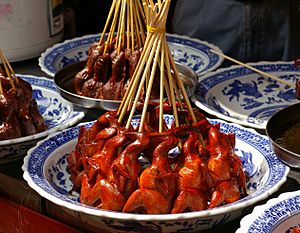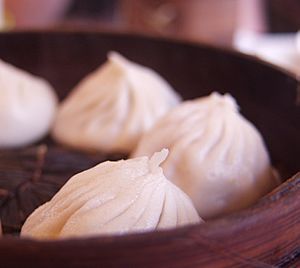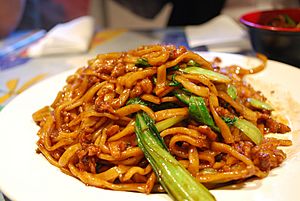Shanghai cuisine facts for kids
Quick facts for kids Shanghai cuisine |
|||||||||||
|---|---|---|---|---|---|---|---|---|---|---|---|
| Shanghai cuisine | |||||||||||
| Chinese | 上海菜 | ||||||||||
|
|||||||||||
| Hu cuisine | |||||||||||
| Simplified Chinese | 沪菜 | ||||||||||
| Traditional Chinese | 滬菜 | ||||||||||
|
|||||||||||

Shanghai cuisine (Chinese: 上海菜; pinyin: Shànghǎi cài; Shanghainese: zaon⁶ he⁵ tshe¹; IPA: [zɑ̃¹¹ he⁴⁴ tsʰᴇ¹¹]), also known as Hu cuisine (simplified Chinese: 沪菜; traditional Chinese: 滬菜; pinyin: Hù cài; Shanghainese: wu⁶ tshe¹; IPA: [ɦu¹¹ tsʰᴇ⁴⁴]), is a popular style of Chinese food. In a narrow sense, Shanghai cuisine refers only to what is traditionally called Benbang cuisine (simplified Chinese: 本帮菜; traditional Chinese: 本幫菜; pinyin: Běnbāng cài; pen⁵ paon¹ tshe⁵; 'local cuisine') which originated in Shanghai. In a broader sense, it refers to complex styles of cooking developed under the influence of neighboring Jiangsu and Zhejiang provinces. It takes "color, aroma and taste" as its elements, like other Chinese regional cuisines, and emphasises in particular the use of seasonings, the quality of raw ingredients and original flavors. Shanghai was formerly a part of Jiangsu province; as such Shanghai cuisine is most similar to Jiangsu cuisine and may still be classified as a part of Jiangsu cuisine, although, as an international city, it has come into more contact with Zhejiang cuisine and foreign influences. The adoption of Western influence in Shanghai cuisine resulted in a unique cooking style known as Haipai cuisine (海派菜).
Contents
Characteristic features
Shanghai dishes often appear red and shiny because they use soy sauce for seasoning. Four classic words are used to describe Shanghai food: "浓油赤酱". This means that Shanghai food uses considerable quantities of oil and soy sauce. Food is cooked using a variety of methods including baking, stewing, braising, steaming and deep-frying. Fish, crab and chicken are made "drunken" using spirits and brisk cooking techniques, and may be steamed or served raw. Salted meats and preserved vegetables are commonly used to enhance various dishes. Sugar is an important ingredient in Shanghai cuisine, especially when used in combination with soy sauce. Another characteristic is the use of a great variety of seafood. Rice is more commonly served than noodles or other wheat products.
Shanghai cuisine emphasizes the use of condiments while retaining the original flavors of raw ingredients. It aims at lightness in flavor and is mellower and slightly sweet in taste compared to some other Chinese cuisines. Sweet and sour is a typical Shanghai taste. An attractive presentation is also important in Shanghai cooking, with ingredients carefully cut and presented with a view to harmonizing colors.
Although Shanghai is a seaport, most families did not incorporate fish in their daily meals in the early 20th century. Eating meat with meals was considered a luxury, with typical meals consisting of vegetables, beans, and rice. In a month, most families typically ate meat or fish for about four meals: on the second, eighth, sixteenth, and twenty-third day of each month. These days became known as dang hun. In recent times, special attention has been paid to low-sugar and low-fat food, with a good quantity of vegetables and improved nutritional value.
History
Shanghai cuisine is the youngest of the ten major cuisines of China, although it still has a more than 400 years of history. Traditionally called Benbang cuisine, it originated in the Ming and Qing dynasties (c. 1368-1840). During the Reign of Emperor Jiaqing and Emperor Guangxu of the Qing Dynasty, a food stall was set up in the old city of Shanghai called "Shovel Bang"(铲刀帮). After 1930, with the rapid development of industry and commerce in Shanghai, the customers of BenBang cuisine became an emerging class mainly composed of employees, and the proportion of cheap dishes in BenBang cuisine began to decline. In the later part of the 19th century, after Shanghai became a major domestic and international trading port, Benbang dishes underwent some substantial changes. After the opening of Shanghai port in 1843, sixteen different catering schools gathered in Shanghai. Anhui cuisine first became popular in Shanghai, and then Suxi cuisine, Cantonese cuisine, Huaiyang cuisine and Beijing cuisine gradually flourished. In the 1930s, Suxi cuisine accounted for almost half of Shanghai's restaurants, while Guangdong cuisine became the synonym of Shanghai's passion cuisine, which was deeply loved by Shanghai residents and foreigners. After adopting influences from other cuisines, the complexity of Shanghai cuisine's flavor has increased.
Also, the adoption of Western influence in Shanghai cuisine developed a unique cooking style known as Haipai cuisine (海派菜). Although eating Western food was a very fashionable way of life at that time, Chinese people had difficulty in adapting to western cuisine at the beginning, such as the rare steak. Shanghai western food then draws on the essence of western food from various countries and gradually forms its own characteristics. Russian Shanghai Western food with one dish and one soup (borscht, bread and butter) is instantly popular in Shanghai due to its economic benefits. Before 1937, there were more than 200 western restaurants in Shanghai, especially Xiafei Road and Fuzhou Road.
Nowadays, Shanghai's traditional cuisine is usually found only in home-cooked meals and some old Benbang restaurants. Shanghai is now more famous in the eyes of most young people for the numerous exotic restaurants it has introduced, especially Japanese and French food.
Notable dishes in Shanghai cuisine
Breakfast
Breakfast in Shanghai is very famous. It contains many categories. They are mainly made from wheat, rice and flour. Many of them are influenced by Cantonese cuisine, Jiangsu and Zhejiang cuisine, and through historical precipitation, these breakfasts have slowly evolved into the favorite flavors of Shanghai people today. The most classic Shanghai Breakfast is called "The Four Warriors" (simplified Chinese: 四大金刚; traditional Chinese: 四大金剛; pinyin: Sìdà Jīngāng; sy⁵ du⁶ cin¹ kaon¹). These are the four most popular breakfast choices for local Shanghainese.
- Glutinous rice rolls (Chinese: 粢飯; pinyin: Cīfàn; tshy¹ ve⁶)
- Soy milk (simplified Chinese: 豆浆; traditional Chinese: 豆漿; pinyin: Dòujiāng; deu⁶ cian¹)
- Chinese cruller (simplified Chinese: 油条; traditional Chinese: 油條; pinyin: Yóutiáo; yeu⁶ diau⁶)
- Sesame pancake (simplified Chinese: 大饼; traditional Chinese: 大餅; pinyin: Dàbǐng; du⁶ pin⁵)
Seafood

- Eel noodles – (simplified Chinese: 鳗鱼面; traditional Chinese: 鰻魚麵; pinyin: Mányú Miàn; moe⁶ ng⁶ mi⁶) – Made with sliced eels and wheat noodles.
- Scallion stewed crucian carp – (simplified Chinese: 葱烧鲫鱼; traditional Chinese: 蔥燒鯽魚; pinyin: Cōngshāo Jìyú; tshon¹ sau¹ ciq⁷ ng⁶) – This is rather involved and complex preparation for the common crucian carp. The dish requires long hours for preparation since the fish needs to be soaked in vinegar, and then deep-fried, stewed for a long prolonged period, and cooled to make the fish tender enough to consume together with all its bones. Due to the complexity of its preparation and the difficulty in perfecting it, the dish was sometimes used by families as a test when recruiting a cook.
- Shanghai hairy crab (Chinese: 上海毛蟹; pinyin: Shànghǎi Máo Xiè; zaon⁶ he⁵ mau⁶ ha⁵) – A variety of Chinese mitten crab. The crab is usually steamed with fragrant ginger, and consumed with a dipping sauce of rice vinegar, sugar and ginger. Mixing crab meat with lard to make Xiefen, and consuming it in xiaolongbao or with tofu, is another highlight of hairy crab season.
- Squirrel-shaped mandarin fish (simplified Chinese: 松鼠桂鱼; traditional Chinese: 松鼠桂魚; pinyin: Sōngshǔ Guīyú; son¹ tshy⁵ kue⁵ ng⁶) – This dish uses fresh mandarin fish. The fish is deep-fried and has a crispy exterior and soft interior. Yellow and red, it is displayed in the shape of a squirrel on the plate. Hot broth is poured over, which produces a high-pitched sound. Sour and sweet flavours are combined in this dish.
Meat and poultry
- Beggar's chicken (simplified Chinese: 叫化鸡; traditional Chinese: 叫化雞; pinyin: Jiàohuā Jī; ciau⁵ ho⁵ ci¹ or ciau⁵ hua⁵ ci¹) – Beggar's Chicken calls for a chicken wrapped in lotus leaves, encased in mud, and roasted in fire, resulting in a delicious and tender meat. According to a legend, a beggar in the Qing dynasty stole and hid a chicken under mud.
- Lion's head (simplified Chinese: 狮子头; traditional Chinese: 獅子頭; pinyin: Shīzi Tóu; sy¹ tsy⁵ deu⁶) – The name derives from the shape of the pork meatball which is supposed to resemble a lion's head and the cabbage (or other vegetables), which is supposed to resemble the lion's mane. It is served in two varieties: the white (or plain), and the red (cooked with soy sauce), and is usually in a white pot.
- Red braised pork belly (simplified Chinese: 红烧肉; traditional Chinese: 紅燒肉; pinyin: Hóngshāo Ròu; ghon⁶ sau¹ gnioq⁸) – The dish is a braised pork belly cooked in Shanghainese soy sauce for a long time, resulting in a juicy and tender meat.
- Sweet and sour spare ribs (Chinese: 糖醋排骨; pinyin: Táng Cù Páigǔ; daon⁶ tshu⁵ ba⁶ kueq⁷) – The fresh pork ribs, which appear shiny and red after being cooked, are traditionally deep fried then coated in a sweet and sour sauce.
Noodles
- Shanghai fried noodles(simplified Chinese: 上海炒面; traditional Chinese: 上海炒麵; pinyin: Shànghǎi Chǎomiàn; zaon⁶ he⁵ tshau⁵ mi⁶) – Shanghai fried noodles are fried thick noodles (sometimes udon) with soy sauce. It is most commonly cooked with bok choy and pork.
- Chilled noodles(simplified Chinese: 冷面; traditional Chinese: 冷麵; pinyin: Lěngmiàn; lan⁶ mi⁶) – This dish is the combination of chilled noodles mixed with different sauces and toppings. Traditionally, the noodles are steamed before cooked for a better taste. After the noodles get cooled down, mix them with sesame oil, soy sauce, and peanut sauce. People usually add more toppings when they make it at home, such as putting whatever leftover food they can find in the fridge.
- Noodle soup(simplified Chinese: 汤面; traditional Chinese: 湯麵; pinyin: Tāngmiàn; thaon¹ mi⁶) – The type of noodle soup that most Shanghai people consume every day is Su-style noodles. It usually has two different soup bases to choose from and people add different toppings (mostly meat) on it.
Soup
- Borscht (simplified Chinese: 罗宋汤; traditional Chinese: 羅宋湯; pinyin: Luósòng Tāng; lu⁶ son⁵ thaon¹)—The dish is made mainly of tomatoes and beef. This is an exotic classic Shanghai dish with local elements of Shanghai cuisine. Because the sweet and sour taste of the dish itself is very popular among Shanghainese. Therefore, after it was introduced to Shanghai from Russia, it has now become a common dish in Shanghai people's homes.

Snacks
- Shengjian mantou (simplified Chinese: 生煎馒头; traditional Chinese: 生煎饅頭; pinyin: Shēngjiān Mántóu; san¹ ci¹ moe⁶ deu⁶) or Shengjianbao (Chinese: 生煎包; pinyin: Shēngjiān bāo; san¹ ci¹ pau¹) – It is typically in a round bun, similar yet thicker than a xiaolongbao (due to the addition of yeast) and is stuffed with pork. It is then pan-fried and seasoned with sesame seeds and chopped scallions.
- Xiaolongbao (simplified Chinese: 小笼包; traditional Chinese: 小籠包; pinyin: Xiǎolóngbāo; shiau⁵ lon⁶ pau¹, known locally as simplified Chinese: 小笼馒头; traditional Chinese: 小籠饅頭; shiau⁵ lon⁶ moe⁶ deu⁶) – A type of steamed bun made with a thin skin of dough and stuffed with pork or minced crab meat, and soup. The delicious soup inside can be held up until it is bitten.
- Guotie (simplified Chinese: 锅贴; traditional Chinese: 鍋貼; ku¹ thiq⁷) or potsticker, is essentially a Jiaozi, but rather than boiled or steamed, they are fried in a pan with oil on one side and then water is added to the pan and covered to steam the rest of the dumpling. Traditionally, Guotie are filled with ground pork and finely chopped Chinese scallions or cabbage.
- Savory mooncakes (simplified Chinese: 鲜肉月饼; traditional Chinese: 鮮肉月餅; shi¹ gnioq⁸ yuq⁸ pin⁵) — This is a very typical Shanghai snack. It is worth noting that mooncakes eaten in most parts of China are actually sweet, with fillings such as sesame seeds, walnuts and red bean paste. But in Shanghai, during the Mid-Autumn Festival, shanghainese eat mooncakes with fresh meat. It's a kind of moon cake with meat wrapped in a pastry. Usually, only some local restaurants will sell this kind of fresh mooncake.
Desserts
- Tangyuan (simplified Chinese: 汤圆; traditional Chinese: 湯圓; pinyin: Tāngyuán; thaon¹ yoe⁶) – A type of sweet dumpling made of glutinous rice flour and stuffed with black sesame. Qibao has a number of tangyuan vendors.
See also
 In Spanish: Gastronomía de Shanghái para niños
In Spanish: Gastronomía de Shanghái para niños



